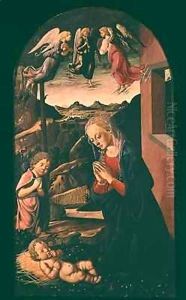di Antonio, (Utili da Faenza) Biagio Paintings
Biagio di Antonio Tucci, often referred to as Biagio d’Antonio or Biagio di Antonio da Firenze, was an Italian painter of the Renaissance period. He was born in 1451 in Florence, though he was also active in other cities such as Faenza, which is sometimes included in his name as an indication of his work there. Biagio di Antonio's style was influenced by the Florentine and the North Adriatic schools of painting.
Biagio's work is characterized by its vibrant color palette and a preference for narratives, often depicting mythological or historical subjects. He was also known for his participation in collaborative works with other artists of his time, which was a common practice during the Renaissance. His collaborators included artists such as Filippino Lippi and Domenico Ghirlandaio. This practice of collaboration makes it sometimes challenging for art historians to attribute certain works to Biagio with certainty.
Throughout his career, Biagio di Antonio did not develop a profoundly individual style, which has led to a certain obscurity regarding his work in the broader context of Renaissance art. Nevertheless, his contributions to various projects, altarpieces, and frescoes have been recognized in the regions where he was active. One of his notable works is the 'Carnival on the Piazza della Signoria', which showcases his ability to depict lively crowd scenes with a multitude of figures.
Biagio di Antonio's career spanned from the late 15th century into the early 16th century, a period that was rich with artistic innovation and the blooming of the High Renaissance. He died in 1516, leaving behind works that are held in various collections and museums, offering insights into the collaborative and vibrant atmosphere of Renaissance workshops.
